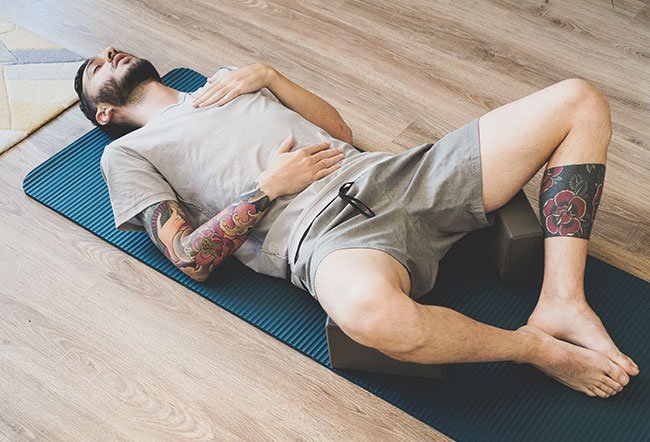What Does Diaphragmatic Breathing Do?

Diaphragmatic breathing is a type of deep breathing exercise that helps you strengthen your diaphragm, which is a large dome-shaped muscular structure located below the lungs and above the stomach.
Advantages include:
- Increasing the strength of your diaphragm
- Reducing the need for oxygen
- Breathing with less effort and energy
Your diaphragm contracts and becomes flat when you inhale air and relaxes to its normal position when you exhale. When practiced intentionally, diaphragmatic breathing improves the efficiency of the lungs and can also help manage stress, calm mood, and improve overall health.
6 health benefits of diaphragmatic breathing
- Reduces blood pressure: Slow breathing is known to reduce sympathetic activity, increasing vasodilation and decreasing blood pressure.
- Improves heart functions: Diaphragmatic breathing increases respiratory muscle strength and endurance. This, in turn, increases the efficiency of respiration and exercise tolerance. Increased exercise tolerance means a reduction of strain on the heart. This is highly beneficial to patients with congestive heart failure.
- Improves respiratory functions: Patients with chronic obstructive pulmonary disorders (COPD) and asthma often have weak respiratory muscles. This may cause occasional episodes of rapid shallow breathing, which can be life-threatening. Diaphragmatic breathing improves the strength of the diaphragm, which decreases breathing disorders and may gradually increase exercise capacity as well.
- Regulates mood: Some studies have suggested that practicing diaphragmatic breathing may help reduce depression, anxiety, and stress.
- Relieves pain: A random controlled study has suggested that slow breathing may alter the perception of painful stimuli and unpleasant emotions, therefore helping relax muscles. Deep breathing may therefore help reduce the intensity of pain.
- Promotes sleep: Based on an assessment of data, the American Academy of Sleep Medicine issued guidelines for the behavioral and psychological management of insomnia. It suggested that relaxation is effective as a standalone therapy for insomnia, although it did not specifically mention the effects of deep breathing. However, some believe that you can achieve relaxation with deep breathing techniques, which in turn could promote better sleep.
How to perform diaphragmatic breathing
Below is a step-by-step procedure for diaphragmatic breathing:
- Find a quiet and comfortable place to sit or lie down.
- Your back should always be straight with your feet on the floor.
- Close your eyes, place one hand below your ribs and another hand on your chest, and breathe normally.
- Take a slow, deep breath, inhaling through your nose.
- Concentrate on your stomach as it expands below your hand.
- Hold the breath as long as you can and exhale slowly through your mouth.
- Pay attention to how the hand on your stomach moves along with your breath.
- Repeat this process until you establish a soothing rhythm.
- As you inhale, imagine how the oxygen is flowing through your body.
- As you exhale, imagine that you are releasing stress and anxiety from your body.
- Repeat until you feel relaxed and less anxious. Gradually increase the duration of the exercise.
To get the most benefits, it is always recommended to maintain a routine and perform breathing exercises at the same time of the day regularly. Once you have mastered the breathing technique, you may be able to do it wherever you are for a few minutes to relieve stress and anxiety.
Are there risks associated with diaphragmatic breathing?
Initially, diaphragmatic breathing may worsen symptoms of anxiety. However, continued practice and mastery over the technique can help reverse this.
People with lung problems, such as asthma, should perform diaphragmatic breathing under medical supervision because it may initially aggravate symptoms such as labored breathing and increased fatigue. However, it is beneficial for most people in the long term.
